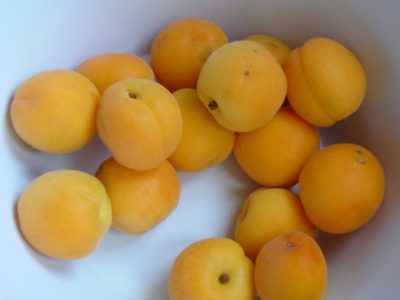
Apricot fruits
The apricot originates from China. The apricot has been cultivated in Armenia for so long that it is often thought to have originated there. This is how it got the scientific name Prunus armeniaca.
Apricots can be eaten fresh but are also often dried. the dried fruits can be used to make drinks or are used in cooking. Some liquors are flavoured with extract of apricot kernels.
Already 5000 years ago, the Chinese used to cultivate apricots. Thousand of years later, the Limburgers, a tribe in southern Netherlands, used these fruits to make "Apricots Vlaai" (see recipe and photo below). Dreaming of apricots, is said to be good luck; dreaming of Apricots Vlaai is even better.
Names
Scientific
Prunus armeniaca
English
Apricot
Dutch
Abrikoos
Spanish
Albaricoque
Albaricoquero
Damasco
French
Abricot
Abricotier
German
Aprikose
Aprikosenbaum
Marille
Italian
Albicocco
Taxonomy
Order
Rosales
Family
Rosaceae
Genus
Prunus
Species
Prunus armeniaca (Apricot)
Basic information and facts
Origin:
China
Distribution:
A lot of apricot is produced in southern Europe: Italy, France, Spain. Also some other countries around the Mediterranean and in Central Asea: Algeria, Marocco, Syria, Turkey, Iran, Pakistan. Apricot is also produced in Japan.
Evergreen or deciduous:
Deciduous
Flowers:
Leaves:
Apricot leaves are ovate (oval shape), about 5 to 9 cm long and 4 to 8 cm wide. They have a pointed tip and a finely serrated margin.
Fruits:
Apricot fruits look like a small peach. The diameter is 1.5 to 2.5 centimeters. Color is yellow to bright orange, sometimes reddish. The surface of the fruit is usually
covered with soft downy hairs. There is one single seed (stone).
Climate and weather:
Apricot likes a continental climate with cold winters. It also grows in Mediterranean climates, but only if winter is cool enough to get a good dormancy.
Pollination:
Bees and bumble bees can help in pollination.
Height:
Apricot trees can be 8 to 12 meters tall.
Crown size:
Blooming period
Early spring. The lowers appear before the leaves.
Spacing (close range)
?
Spacing (wide range)
?
Propagation:
Grafting. Sometimes apricot cultivars grafted on rootstocks of plum or peach. Grafting with multiple cultivars can promote cross pollination.
Insect pests:
Diseases:
Fruit development:
Harvesting:
Hand picking the ripe fruits.
Uses:
Fruits are eaten fresh as a snack or dessert fruit but are also dried. Fruits are used in cakes, vlaai, fruit pies, etc.
Proverbs and Quotes
- The only thing better than this is an apricot in Damascus (Turkish expression, which means “it doesn’t get any better than this”)
Did you know that?
- Apricot is the national fruit of Armenia.
- The so called “black apricot” is a hybrid between an apricot and a plum. They are also called plumcots, apriplums, pluots, and apriums.
Recipes
Apricots vlaai
Vlaai is a kind of pie made of sweet pastry and different types of fruit filling. It originates from the south of the Netherlands (Limburg province). A very famous type of vlaai is apricot vlaai.
Ingredients (for 2 vlaaien):
For the dough: 500 gram white wheat flour, 150 gram butter (margarine), yeast (about 25 g), warm milk (about 125 ml), some white soft sugar
Instructions for the dough:
Flour and small pieces of margarine in a bowl. Make a hole in the middle and put the yeast there. Some soft white sugar on the yeast. Part of the warm milk over the yeast. Start kneading from the middle. Slowly add more milk until you have a dough. It should not stick to the fingers. Place the dough in a warm place, covered with a cloth, and let it lift.
Then take half of the dough. Knead it very shortly. Take a round oven plate (metal dish for making vlaai) and grease it with some margarine. Put the dough on the plate. Cover it with a cloth and let it lift again for a few minutes.
Then press the dough flat covering the shape of the plate. Cover it with the apricots (should be cold, see below). Bake it in a preheated oven, about 15 minutes at high temperature.
Instructions for the apricots:
Use tins of apricots. Heat it with a bit of water. When almost boiling, thicken it with some potato starch. Let it boil very short. Then let it cool down before using it on the dough.
Crop categories
Cool temperate crops
Fruits
High altitude crops
Major crops
Mediterranean crops
Subtropical crops
Temperate crops
Pictures

Apricot tree

Apricots

Apricots in can

Apricot vlaai
